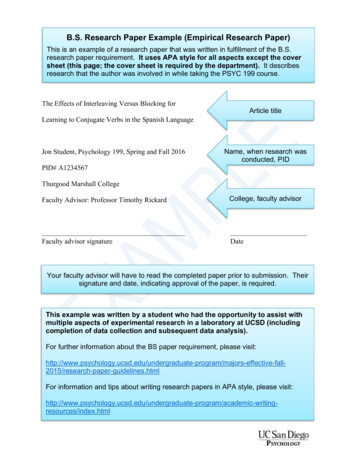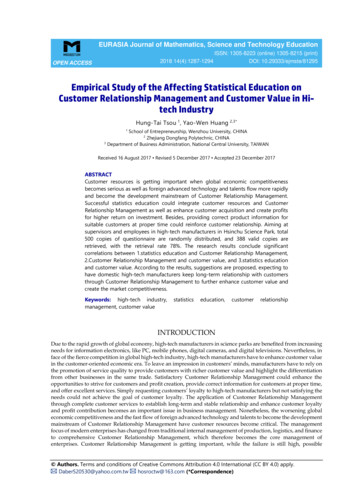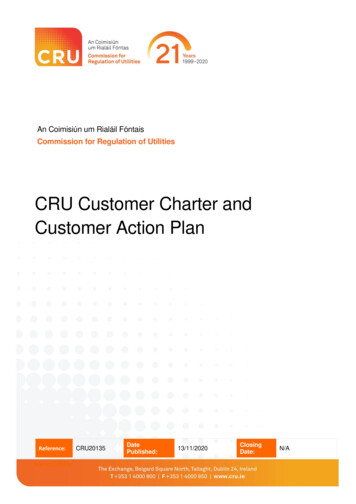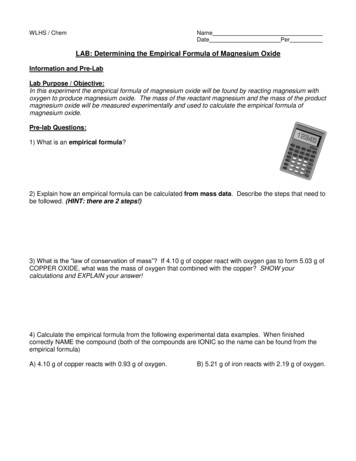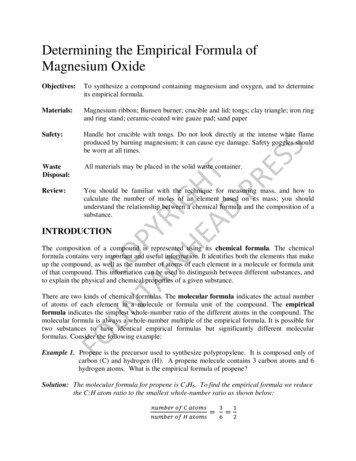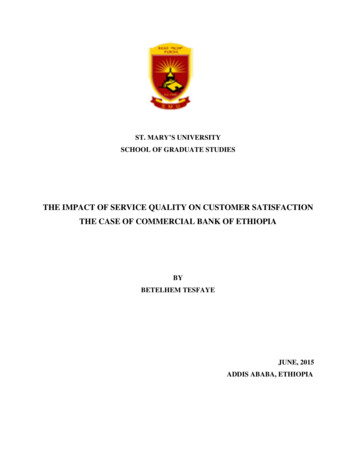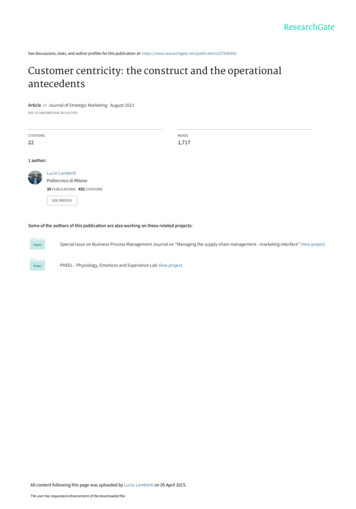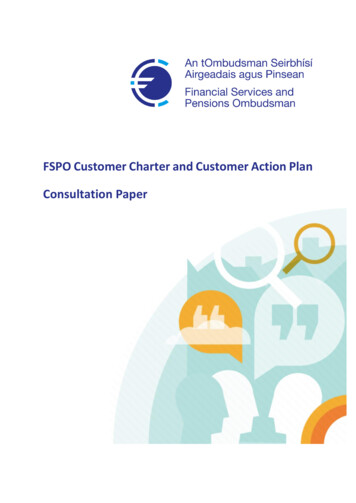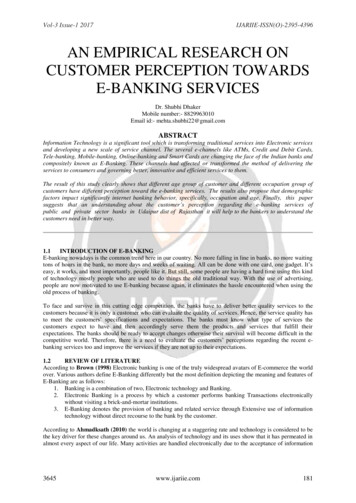
Transcription
Vol-3 Issue-1 2017IJARIIE-ISSN(O)-2395-4396AN EMPIRICAL RESEARCH ONCUSTOMER PERCEPTION TOWARDSE-BANKING SERVICESDr. Shubhi DhakerMobile number:- 8829963010Email id:- mehta.shubhi22@gmail.comABSTRACTInformation Technology is a significant tool which is transforming traditional services into Electronic servicesand developing a new scale of service channel. The several e-channels like ATMs, Credit and Debit Cards,Tele-banking, Mobile-banking, Online-banking and Smart Cards are changing the face of the Indian banks andcompositely known as E-Banking. These channels had affected or transformed the method of delivering theservices to consumers and governing better, innovative and efficient services to them.The result of this study clearly shows that different age group of customer and different occupation group ofcustomers have different perception toward the e-banking services. The results also propose that demographicfactors impact significantly internet banking behavior, specifically, occupation and age. Finally, this papersuggests that an understanding about the customer’s perception regarding the e-banking services ofpublic and private sector banks in Udaipur dist of Rajasthan it will help to the bankers to understand thecustomers need in better way.1.1INTRODUCTION OF E-BANKINGE-banking nowadays is the common trend here in our country. No more falling in line in banks, no more waitingtons of hours in the bank, no more days and weeks of waiting. All can be done with one card, one gadget. It’seasy, it works, and most importantly, people like it. But still, some people are having a hard time using this kindof technology mostly people who are used to do things the old traditional way. With the use of advertising,people are now motivated to use E-banking because again, it eliminates the hassle encountered when using theold process of banking.To face and survive in this cutting edge competition, the banks have to deliver better quality services to thecustomers because it is only a customer who can evaluate the quality of services. Hence, the service quality hasto meet the customers’ specifications and expectations. The banks must know what type of services thecustomers expect to have and then accordingly serve them the products and services that fulfill theirexpectations. The banks should be ready to accept changes otherwise their survival will become difficult in thecompetitive world. Therefore, there is a need to evaluate the customers’ perceptions regarding the recent ebanking services too and improve the services if they are not up to their expectations.1.2REVIEW OF LITERATUREAccording to Brown (1998) Electronic banking is one of the truly widespread avatars of E-commerce the worldover. Various authors define E-Banking differently but the most definition depicting the meaning and features ofE-Banking are as follows:1. Banking is a combination of two, Electronic technology and Banking.2. Electronic Banking is a process by which a customer performs banking Transactions electronicallywithout visiting a brick-and-mortar institutions.3. E-Banking denotes the provision of banking and related service through Extensive use of informationtechnology without direct recourse to the bank by the customer.According to Ahmadksath (2010) the world is changing at a staggering rate and technology is considered to bethe key driver for these changes around us. An analysis of technology and its uses show that it has permeated inalmost every aspect of our life. Many activities are handled electronically due to the acceptance of information3645www.ijariie.com181
Vol-3 Issue-1 2017IJARIIE-ISSN(O)-2395-4396technology at home as well as at workplace. Slowly but steadily, the Indian customer is moving towards theinternet banking. The ATM and the Net transactions are becoming popular.But the customer is clear on one thing that he wants net-banking to be simple and the banking sector is matchingits steps to the march of technology. E-banking or Online banking is a generic term for the delivery of bankingservices and products through the electronic channels such as the telephone, the internet, the cell phone etc. Theconcept and scope of e-banking is still evolving. It facilitates an effective payment and accounting systemthereby enhancing the speed of delivery of banking services considerably (Indiana Department of FinancialInstitutions).Source: - commons.wikimedia.org1.3 CONCEPT OF E-BANKINGElectronic banking, also known as Electronic Funds Transfer (EFT), is simply the use of electronicmeans to transfer funds directly from one account to another, rather than by cheque or cash. It may useelectronic funds transfer to (Bitner, 1990)Withdraw money after checking account from an ATM machine with a personal identification number(PIN), according to our convenience, day or night.Instructions by the bank or credit union to automatically pay certain monthly bills from our account,such as our auto loan or mortgage payment.Having the bank or credit union transfer funds each month from checking account to our mutual fundaccount.Have government social security benefits check or our tax refund deposited directly into our checkingaccount.Source: - www.securitystateonline.comUses of E-BANKING Buy groceries, gasoline and other purchases at the point-of sale, using a check card rather than cash,credit or a personal check. Use a smart card with a prepaid amount of money embedded in it for use instead of cash at a payphone, expressway road toll, or on college campuses at the library's photocopy machine or bookstores. Use computer and personal finance software to coordinate total personal financial managementprocess, integrating data and activities related to income, spending, saving, investing, recordkeeping,bill-paying and taxes, along with basic financial analysis and decision making.3645www.ijariie.com182
Vol-3 Issue-1 2017IJARIIE-ISSN(O)-2395-4396Need for E-BankingAccording to Malika (2012) “One has to approach the branch in person, to withdraw cash or deposit acheque or request a statement of accounts. In true Internet banking, any inquiry or transaction isprocessed online without any reference to the branch (anywhere banking) at any time. ProvidingInternet banking is increasingly becoming a "need to have" than a "nice to have" service. The netbanking, thus, now is more of a norm rather than an exception in many developed countries due to thefact that it is the cheapest way of providing banking services”.Banks have traditionally been in the forefront of harnessing technology to improve their products,services and efficiency. They have, over a long time, been using.1.4BANK INFORMATION TECHNOLOGY CUSTOMERElectronic and telecommunication networks for delivering a wide range of value added products andservices. The delivery channels include direct dial – up connections, private networks, public networksetc and the devices include telephone, Personal Computers including the Automated Teller Machines,etc. With the popularity of PCs, easy access to Internet and World Wide Web (WWW), Internet isincreasingly used by banks as a channel for receiving instructions and delivering their products andservices to their customers. This form of banking is generally referred to as Internet Banking, althoughthe range of products and services offered by different banks vary widely both in their content andsophistication.Changing Scenario of IT in the YearsThe technology in Indian industry is changing immensely. Kaushal (2012) identified the changingscenario of IT in the Indian banks in the years of 1990 and 2000 is as follows: HRM/IR: In 1990, there was a problem of overstaffing, high turnover of IT professionals, absence ofattractive terms and career progression for IT technologies.In 2000, web based portals were designed for IT training and there was need to set up a separate ITinstitute for banking industry.EDP/IT Organizational Set-up: In 1990, telecommunication, security, audit and disaster recoverydepartment set-up was still absent in majority of banks.In 2000, need for IT security, audit, control and disaster recovery was felt to minimize IT related risks.IT Management: In 1990, IT management functioning remained highly centralized.By 2000, as IT investment grew and its usage spread, professional IT management was required acrossthe hierarchy of the banks.IT Infrastructure: In 1990, telecommunication /ATM projects initiated yet to deliver required supportboth from customers and management.By 2000, huge investment was needed to create necessary IT infrastructure and strategies to ensureROI.Banking Business and its Spread: In 1990, emergence of new private and foreign banks resulted intoneed for new products and services.By 2000, demand for e-commerce, internet based “One Stop Shopping” of financial services gainedmomentum.IT Audit, Security and Control for Risk Management: In 1990, many frauds were yet to surface.ROI in IT was still not done adequately.By 2000, relevant software packages were used for IT audit.Management Function and IT Support: In 1990, there was absence of management support systemand decision support system for vital functions of management like credit investment, asset liabilitymanagement.By 2000, indigenous solution for local problems based on technological innovations was needed.IT Audit/Security/Control Related Awareness and Culture: In 1990, password management yet notadequate, controls and inbuilt audit trials were far from satisfactory.By 2000, IT audit and control had been the responsibility of every employee of the bank as IT wouldbecome lifeblood of the financial system.So, technological changes transformed the banking systems and structure mainly in the years 1990 and2000 and the major changes were related to risk, security, control, IT infrastructure, IT managementand organizational set-up.3645www.ijariie.com183
Vol-3 Issue-1 20171.5IJARIIE-ISSN(O)-2395-4396OBJECTIVES OF THE STUDY1.To examine the relationship between the E-Banking services and their acceptance by customers withreference to customers of selected banks.2.To study the customer perception for the E-Banking services offered to them with reference tocustomers of selected banks.1.6RESEARCH METHODOLOGYSampling ProcedureFor collecting data from respondents’ convenience sampling procedure is followed. Under thisprocedure it is taken care of that responses are collected from only those respondents who are able tounderstand the necessity of the research, and can interpret that any of the fruitful outcomes willdefinitely benefited them by more supervised advertisement content without misleading and fraud typeof information dissemination. One of the major issues was under consideration while selecting therespondents was that the respondents should be aware about the services offered by E-Bankingchannels and their banks.1.7RELIABILITY FOR DATA COLLECTEDReliability coefficient tested by using Cronbach’s alpha (α) analysis. In order to measure thereliability for a set of two or more constructs, Cronbach’s alpha is a commonly used method wherealpha coefficient values range between 0 and 1 with higher values indicating higher reliability amongthe indicators (Hair, et al., 1992).Table 1.1: Case Processing SummaryCase Processing SummaryCasesN%Valid100100.0Excluded a0.00.0Total100100.0a. List wise deletion based on all variables in the procedure.Source: Author’s CompilationFrom the above Table 1.1 it could interpret that total case followed under examinations which werefound valid were 100. Total numbers of cases were 100. No missing or excluded cases were recognized. All theresponses collected through respondents and governed by the questionnaire were systematically filled andspecific attention was given to all the respondents if required so that proper and confirmed responses about theissues could be collected.Table 1.2: Reliability StatisticsCronbach's AlphaN of Items.897100Source: Author’s CompilationFrom above Table 1.2 it could recognized that Cronbach value for the responses of the 100 respondents of thestudy was found .897 which is an excellent representation of the quality of data and confirms approx 89.7 %reliability of the collected data. Cronbach's a (alpha) is an important psychometric instrument to measure thereliability of data. The reliability coefficient indicates that the scale for measuring trust and commitment is areliable. So, various statistical tools can be applied and tested.1.83645ANALYSIS OF RELATIONSHIP BETWEEN DEMOGRAPHIC VARIABLES AND USAGEOF E-BANKING SERVICESwww.ijariie.com184
Vol-3 Issue-1 2017IJARIIE-ISSN(O)-2395-4396Analysis of relationships between demographic variables of respondents and related usage of E-Bankingservices by the respondents will be presented in this section of the research paper. In order to investigate therelationship between demographic variables like educational qualification, age, gender and occupation and theusage of E-Banking services by the respondents following hypotheses were formulated.Ho1: There is no relationship between the Gender and usage of E-Banking service.H11: There is relationship between the Gender and usage of E-Banking service.Ho2: There is no relationship between the Age and usage of E-Banking service.H12: There is relationship between the Age and usage of E-Banking service.Ho3: There is no relationship between the Educational Qualification and usage of E-Banking service.H13: There is relationship between the Educational Qualification and usage of E-Banking service.Ho4: There is no relationship between the Occupation and usage of E-Banking service.H14: There is relationship between the Occupation and usage of E-Banking service.Consequences of Examination of Relationship between Demographic Variables and Usage Pattern of EBanking services by the RespondentsTable 1.3: Test of Homogeneity of Variance for Gender and Usage of E-BankingTest of Homogeneity of VariancesUsage Pattern of E-Banking servicesLevene Statisticdf1df2Sig.728198.523Source: Primary DataTable 1.4: One Way ANOVA for Gender and Usage of E-Banking ServicesANOVAUsage Pattern of E-Banking servicesSumSquaresofdfMean n Groups245.32982.503Total250.55699Source: Primary DataLevene’s Test for Equality of Variance is performed to test condition that the variances of both samples areequal or not. A high value results normally in a significant difference, but in Table 1.3 result sig. .523, whichcould interpret as no equal variance.In the Table 1.4 the variation (Sum of Squares), the degrees of freedom (df), and the variance (Mean Square)are given for the within and the between groups, as well as the F value (F) and the significance of the F (Sig.).Sig. indicates whether the null hypothesis – the population means are all equal – has to be rejected or not. As itcan see, there is good difference between the two Mean Squares (5.236 and 2.503), resulting in a non significantdifference (F 2.091; Sig. 0.058). The Sig. value is higher than the Sig. level of 0.05. This means that H013645www.ijariie.com185
Vol-3 Issue-1 2017IJARIIE-ISSN(O)-2395-4396must be accepted which states that there is no relationship between the gender and usage pattern of E-Bankingservices offered to them by their banks. Both male and female equally use the E-Banking services and showspositive response for it.Table 1.5: Test of Homogeneity of Variance for Age and Usage of E-Banking ServicesTest of Homogeneity of VariancesUsage Pattern of E-Banking servicesLevene Statisticdf1df2Sig.1.235396.002Source: Primary DataTable 1.6: One Way ANOVA for Age and Usage of E-Banking ServicesANOVAUsage Pattern of E-Banking servicesBetween GroupsSumofSquaresdfMean 2299Within GroupsTotalSource: Primary DataAccording to Table 1.5 it could interpreted that because sig. .003 so equal variance could be assumed.According to Table 1.6 it could interpret that there is difference between the two Mean Squares (2.177 and2.642), resulting in a significant difference (F 0.823; Sig. 0.032). The Sig. value is lower than the Sig. levelof 0.05. This means that H02 must be rejected which states that there is relationship between the age and usagepattern of E-Banking services offered to respondents by their banks. Thus the usage of E-Banking services is notequal for the different age group (Under 20 Years, 21-30 Years, 31-40 Years and Above 41 Years) people /respondents.Table 1.7: Test of Homogeneity of Variance for Educational Qualification and Usage of E-BankingServicesTest of Homogeneity of VariancesUsage Pattern of E-Banking servicesLevene Statisticdf1df2Sig.1.6244950.103Source: Primary Data3645www.ijariie.com186
Vol-3 Issue-1 2017IJARIIE-ISSN(O)-2395-4396Table 1.8: One Way ANOVA for Educational Qualification and Usage of E-Banking ServicesANOVAUsage Pattern of E-Banking servicesSum of SquaresdfMean 35199Between GroupsWithin GroupsTotalSource: Primary DataAccording to Table 1.7 it could interpreted that because sig. .016 so equal variance could be assumed.According to Table 1.8 it could interpret that there is difference between the two Mean Squares (1.307 and2.474), resulting in a significant difference (F .5283; Sig. 0.042). The Sig. value is lower than the Sig. levelof 0.05. This means that H03 must be rejected which states that there is relationship between the educationalqualification and usage pattern of E-Banking services among the respondents. Thus the usage pattern of Ebanking services among the respondents is not equal for the respondents of different qualification backgroundlike below secondary, higher secondary, graduate, post graduate and professional degree holder. Meanseducational qualification significantly affects the usage pattern of E-banking services.Table 1.9: Test of Homogeneity of Variance for Occupation and Usage of E-Banking ServicesTest of Homogeneity of VariancesUsage Pattern of E-Banking servicesLevene Statisticdf1df2Sig.1.23551940.32Source: Primary DataTable 1.10: One Way ANOVA for Occupation and Usage of E-Banking ServicesANOVAUsage Pattern of E-Banking servicesSumofSquaresdfMean ween GroupsWithin GroupsTotal544.903Source: Primary DataAccording to Table 1.9 it could interpreted that because sig. .023 so equal variance could be assumed.According to Table 1.10 it could interpret that there is difference between the two Mean Squares (0.4246 and5.774), resulting in a significant difference (F .0735; Sig. 0.032). The Sig. value is lower than the Sig. levelof 0.05. This means that H04 must be rejected which states that there is relationship between the occupation and3645www.ijariie.com187
Vol-3 Issue-1 2017IJARIIE-ISSN(O)-2395-4396usage pattern of E-Banking and related services. Thus the usage pattern of E-Banking and related services is notequal for the respondents of different occupation background like student, Govt. Service, Private Service,business and Professional. It could easily be interpret that a working person will frequently use the E-Bankingchannels like ATM, Internet Banking rather than students, at the very same time person working in private jobs,businessman and professional uses E-Banking services frequently rather than the government service associatedpersons.Table 1.11: Status of Hypotheses established for analysis the relationship between demographic variablesand Usage Pattern of E-Banking servicesS. No.1.2.3.4.HypothesesH01H02H03H04DifferenceNon AcceptedRejectedRejectedRejectedSource: Author’s CompilationSo by the acceptance and rejection of hypotheses formulated for investigating the relationship betweendemographic variables like educational qualification, age, gender and occupation and the usage of E-Bankingservices by the respondents it could interpreted that age, educational qualification and occupation are thesignificant variables and usage of E-Banking and related services varies according to age, education, Occupationand only gender variable did not found significant means there is no variation for gender (male and female) forthe usage of E-Banking services.CONCLUSIONSo we could better conclude that E-Banking service had improved quality of Banking services whichsignificantly improving the customer satisfaction, customer base, banks benefits and many more. It was alsoobserved that customers are deriving several benefits from the E-Banking over their traditional way of banking.Several negative and positive factors significantly affecting the adoption but banks should work to eliminate thenegative issues.SUGGESTIONS FOR BANK CUSTOMERSFollowing issues should be administered by the customers for successful implementation of technologicaldevelopment of methods implementation in banking activities.1.2.3.4.5.6.7.Customer should be curious to make himself literate for the new trends of banking activities.Customer should show his positive participation in training program organized by banks for them.Customer should ask for help as and when they face any problem in any E-Banking activities.Customer should submit their feedback to improve the quality of services.Customer should follow the guidelines supervised for availing any E-Banking service.Customer should carefully read all the help directions or files properly so that they could makethemselves aware for the system or procedure of E-Banking.Positive participation in development of E-Banking onsumerbehavior”,http://www.google.co.in/url?sa t&rct j&q &esrc s&source web&cd 3&cad rja&ved 0CDgQFjAC&url FINTRODUCTION-OF-EBANKING&ei F3LwUtBitner, M.J.; B.H Booms and M.H. Tetreault (1990), “The Service Encounter Diagnosing Favourable andUnfavourable Incidents”, Journal of Marketing, Vol. 54, January, pp.71-84.Brown, Stephen N.; and Teresa A. Swartz (1989), “A Gap Analysis of Professional Service Quality”, Journal ofMarketing, Vol. 53, (April), pp. 92-98.3645www.ijariie.com188
Vol-3 Issue-1 nancialInstitutions,http://www.google.co.in/url?sa t&rct j&q &esrc s&source web&cd 5&cad rja&ved 0CEsQFjAE&url http%3A%2F%2Fwww.in.gov%2Fdfi%2FWHAT IS ELECTRONIC BANKING MINI.doc&ei XgbyUrzRBoOxrgfkh4DoDg&usg AFQjCNHwrvRpMhPIQ97PsCjgSou7fyIHiA&sig2 tSKxc5npwKONg2PLs7iFSw&bvm bv.60799247,d.bmkKushal (2012). In Ferozepur District Zenith International Journal of Multidisciplinary Research Vol. 2 Issue,January 2012, ISSN 2231 5780Malika Rani (1997), “A Study On The Customer Perception Towards e-banking” Start Ellen What to knowbefore you spend cyber dough , Money Magazine, pp. 33-35, (January 1997).3645www.ijariie.com189
E-Banking are as follows: 1. Banking is a combination of two, Electronic technology and Banking. 2. Electronic Banking is a process by which a customer performs banking Transactions electronically without visiting a brick-and-mortar institutions. 3. E-Banking denotes the provision of banking and related service through Extensive use of information

